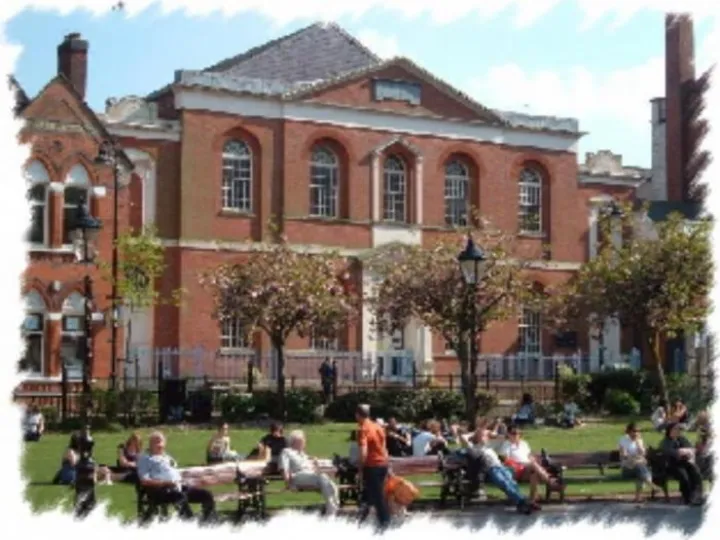The Building
Bishop Street Methodist Church has been here since 1815 and is an important part of Leicester's Heritage. Like most places of worship the Chapel building has been adapted and extended over the years with different generations of the people who have worshipped here each leaving their mark. The building and fittings have changed to meet their needs and those of the city. This is a process which is still going on today.
The Setting
The frontage of the Chapel now looks out onto Town Hall Square, with its cherry trees and central fountain. Handsome buildings dating from the later nineteenth and early twentieth century make up the Square the Reference Library (1904), the former Central Post Office, and of course, the Town Hall itself (1873).
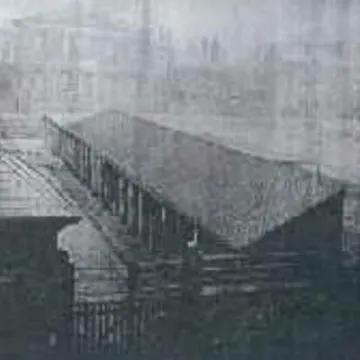
However, this Chapel is older than them all, indeed one of the oldest buildings to survive in this part of the City. When it was built, it looked out, not onto the grand civic square, but a cattle market. It was probably only because this was a dirty (and no doubt smelly) part of the town that the early Methodists were able to afford to buy a site here.
The front of the Chapel has altered relatively little since it was built. The design is symmetrical, with ordered rows of round-arched windows. There are details taken from classical architecture and this is very typical of building style in the Georgian period. This Classical style with its elegant simplicity was popular for nonconformist places of worship at that time.
The architect of this Chapel was himself a Methodist Minister, Rev. William Jenkins. He knew from personal experience what was important in a Chapel building. Jenkins designed chapels across the British Isles. The best preserved of these is Walcot Chapel near Bath. The closest in appearance to Bishop Street is the Chapel he designed in Carver St, Sheffield.
Inside the Chapel
The central door is a later addition to the Chapel, one of the many alterations undertaken in 1883. Originally the Chapel was entered by the large doors on the left and right. The foyer was created in the late 1960s and refurbished in 1994.
The original Chapel building was practically square with a high flat ceiling. This 'box-like' design was intended to enable the congregation to hear the preacher clearly and such churches are called 'auditory' churches (churches for hearing).
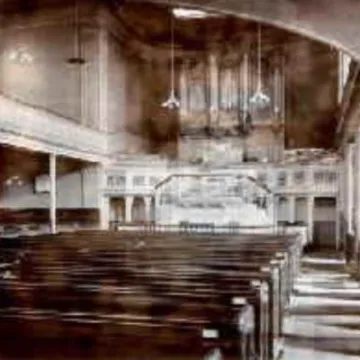
The interior has been extended and altered through the years. In 1847 the church was extended southwards, and the choir/organ area created above the vestry. The whole interior was dramatically remodelled in 1883. The present pulpit and communion area dates mostly from 1894 although the communion rail may be rather older than that. During and after the First World War the interior was altered again, the roof was renewed, and the present arched ceiling added. This ceiling closely resembles early Cinema design and may have been intended to make the interior look more 'up to date'. The Gallery tip-up seats were also a feature more at home at a cinema. Each seat incorporates a wire hat rack, so your bowler or top hat could be safely stowed under your seat. The pews downstairs were installed in the late 19th century, replacing the previous box pews. The new pews were numbered, so they could be rented to particular individuals at that time. There are also fold-down bench seats fixed to the walls to provide extra seating when required.
The Worship Focus

Nearly all the elements of the pulpit and communion area date from the remodelling of the Chapel in 1894. This 'rostrum', which many consider resembles a wedding cake, follows the elaborate Italian Renaissance Style. The ornate wrought iron panels may have been made by blacksmiths in Narborough. The arrangement of this part of the church and the emphasis given to the different elements are very typical of the design of Methodist Churches in the late nineteenth and early twentieth centuries. Although these fittings are elaborate, there are no figurative images. The gilded cross is empty, not only reminding worshippers of the Crucifixion but expressing Jesus's resurrection and his triumph over death.
In central place, encircled by a wooden rail, is the communion table for the celebration of Holy Communion (also known as the Lord's supper). This commemoration of the Last Supper, in which worshippers share in bread and wine, is very important to many Christians. Those partaking can kneel at the rail. The small regular holes pierced in the wooden ledge behind the rail are designed to hold the individual glasses typically used in Methodist celebrations of the Lord's Supper. From John Wesley onwards the Methodist Church has had a strong tradition of opposing the abuse of alcohol. For this reason, by the late nineteenth century, most Methodist Churches stopped using alcoholic wine at communion. The individual glasses, an innovation from America, prevented the spread of disease once alcoholic wine was abandoned.
Above the table is a broad pulpit. The elevation of the pulpit expresses the centrality of preaching in Methodism. It also serves a practical purpose enabling the preacher to be seen and heard by the many worshippers seated in the gallery. Beyond this are the choir stalls. On either side are boards for the display of hymn numbers.
The Organ
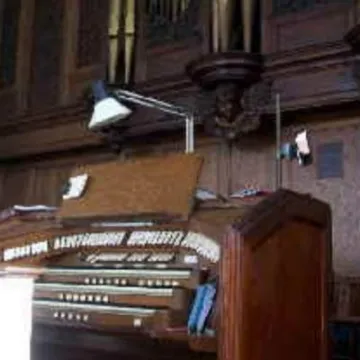
Originally music for worship was provided by a small orchestra. Only in the mid-19th century was an organ thought appropriate. In 1858 the organ was installed which now dominates the worship focus and is the oldest object in the Chapel, indeed it is much older than the building, probably dating back to the 1680s or '90s. The case is traditionally ascribed to the famous organ builder Father Smith of Bremen. It has delicate panels of carving including two substantial cherub heads. Although the organ was bought from an organ builder in London, it's casework had previously been in the Church of St Margaret in Leicester. The organ was extensively remodelled in 1936 by the 'Organ Builders to King George V', and it is likely that none of Father Smith's original pipes remain. Nevertherless, the organ case was classed in a recent report as being of exceptional significance, and the instrument itself is regarded as one of the best in Leicestershire. See more details on the Organ page.
Members and Memorials
On either side of the worship focus are First World War Memorials from this Chapel and from sister congregations who formerly met at the Temperance Hall and Mansfield Street Mission. Many of the individual fittings in the Chapel were given in memory of members of this church or other associated churches which are no longer open. Further names are recorded in our church records. If you think that an ancestor of yours may have been a church member, our War Memorial names and our Baptismal register from 1877 onwards are now on the heritage section of our website at www.bishopstreetchurch.org.uk
Rooms and Meetings
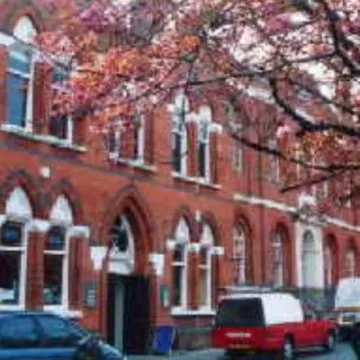
The Chapel is the heart of a complex of rooms developed for meeting, education and charitable work. In the nineteenth century the Minister lived on site in the building now occupied by the Zinthiya Trust. In 1873 a large Sunday School, designed by Burton and Willoughby, was built on the east side of the Chapel. By the middle of the 20th Century, changing patterns of city life meant a Sunday School of that size was no longer needed. After spells as a carpet warehouse and a magistrates court it was refurbished in the 1990s, and now houses the Zinthiya Trust Community Shop, Community Cycles and the Leicester Council of Faiths Office. Within the main Church building, our church rooms and lower hall provide a range of different meeting and activity spaces, and are now used extensively by community/self helps groups and organisations.
Redevelopment
The recent changes to the main church have involved removing the side pews, which opened up areas under the galleries for exhibitions, stands and displays. More recently we installed a ramped entrance and a more open layout for the area where we worship, which is now open to the public all through the week with 'The Chapel Café'. The new layout gives much greater flexibility of use while protecting and sustaining the heritage of the chapel, with a high quality worship, performance and meeting venue and an exhibition space for art and heritage exhibitions and to showcase our own heritage, activities and concerns and the work of local groups, charities and organisations. The serenity and beauty of this historic space is accessible to the people of Leicester, not only during special events, but every day.
A short booklet, John Wesley in Leicestershire, published by Kairos Press in 1988, provides fuller information on this, and is available from Kairos Press, or direct from Bishop Street Methodist Church.
Quick Links
Get In Touch
10a Bishop Street, Town Hall Square,
Leicester, LE1 6AF

